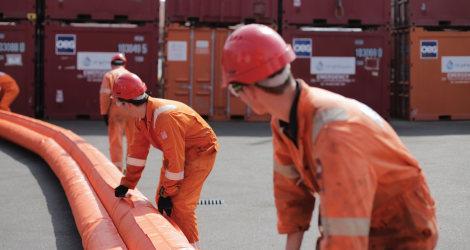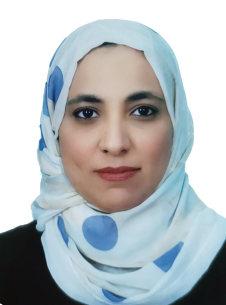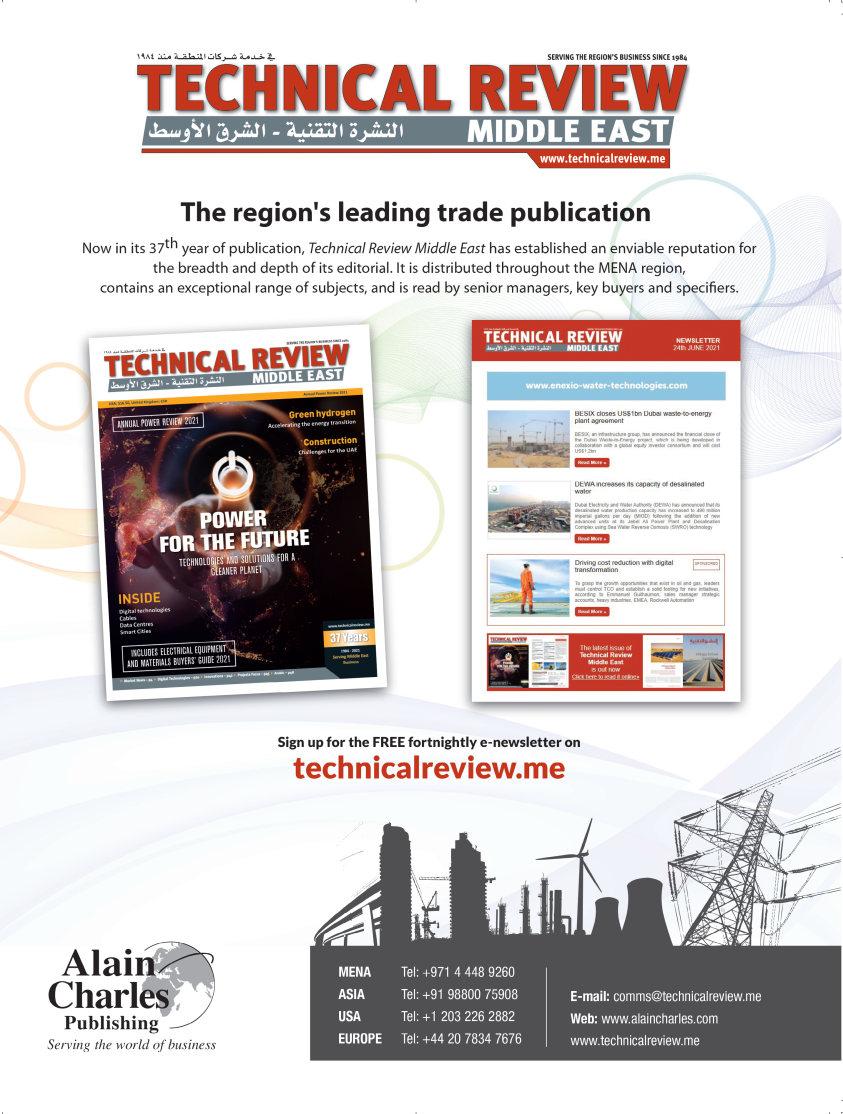
12 minute read
Ten things to do to improve oil spill preparedness
Ten things to do to improve oil spill
preparedness
Oil spill preparedness within oil companies may have waned during the pandemic. Lucy Short, principal consultant at Oil Spill Response Ltd (OSRL) provides some guidance to help organisations put in place some prevention barriers and readiness actions.
AS WE START to return to a new normal Lucy Short, principal consultant at OSRL, advises oil companies to assess the level of investment in oil spill preparedness over the last 12 months; the knowledge lost through headcount reductions; and the short-term actions to ensure they remain prepared to respond to an oil spill incident. In a blog, she highlights 10 steps which can help companies to do this: 1. Make sure your Oil Spill Contingency Plan (OSCP) or Oil Spill Response Plan (OSRP) is current, referencing the correct hydrocarbons and risks ratings, and reflecting your company’s latest HSE protocols. Refresh your mind on oil spill response procedures, roles and responsibilities. 2. Review your relevant government guidelines and protocols to check whether anything has changed, which your plan needs to reflect if there is a new protocol or a new level of adherence to a convention required, then you will need to check how this will impact your OSCP/OSRP response model, communication lines and equipment. 3. Check your equipment to see if it looks in good working condition. Note any anomalies and capture them in a central system for further action. Assemble and run the equipment with trained and competent personnel if you can, and assess whether the equipment is commensurate with the risk and suitable to mount a tier 1 response. 4. Restart your team exercises or do an oil spill scenario. Whether your emergency response team is still remote, fully back in the workplace, or half/half, now would be a suitable time to do this. Including an oil spill scenario would be beneficial to test/refresh team knowledge. It would also be good to test the communication lines between those still working from home, those at the facility and those at the exercise site. 5. Review the oil spill response knowledge and competence retained in your Incident Command Team. Speak to everyone about their role in the incident management team (IMT) and see how competent they feel regarding their knowledge retained. Assess their confidence in their ability to support an oil spill response incident and review their training and exercise records. See what extra training they could do to further their knowledge. If an employee’s accreditation has expired, they will need to attend a refresher course to maintain their accredited training standard. 6. See what free relevant oil spill response courses there are online to refresh your knowledge from companies such as IPIECA, GIWACAF and OSRL. 7. Check out the IPIECA/IMO/IOGP websites for up-to-date knowledge sharing, good practice guides and industry updates. 8. Communicate with the Incident Command/Management Team, Crisis Management Team and the wider business regarding the oil spill response status of your business/operation/facility. Taking the time to share the status of your OSCP/OSRP, the equipment and response techniques with relevant staff ensures that they remember the importance of remaining skilled and knowledgeable on the subject and that they are confident to be part of an oil spill response team.
9. Empower your team to share knowledge and do further (free) training if necessary and available. As part of your incident/emergency command team meetings, have a knowledge sharing session where each team member shares something they have learnt or something that resonates with them about oil spill response. 10. Use an online oil spill response capability review tool. Check out this tool, it is simple to use and freely available to undertake a simple capability review of youroperations: https://www.oilspillresponse .com/tools/ready-check/ n
Now is a good time to restart team exercises.
To view the full article and links to further resources, see https://www.oilspillresponse.com/news-media/blog/how-to-improve-yourpreparedness/ Oil Spill Response Limited (OSRL) is the largest international industry-funded cooperative which exists to respond to oil spills wherever in the world they may occur, by providing preparedness, response and intervention services. https://www.oilspillresponse.com
Behaviour-based safety for enhanced
safety performance
Yousra Kindi, senior behavioural safety adviser, Petroleum Development Oman (PDO), discusses PDO’s IHTIMAM programme, which has had a major impact on safety performance throughout PDO and its contractor companies.
Can you outline PDO’s behaviour-based safety programme, and its role in improving safety culture? What do you think are its main achievements?
Behaviour-based safety, when implemented correctly and sustained, can improve safety performance by raising awareness and the ability to recognise hazards among the workforce, reinforce positive safe behaviour, promote intervention, encourage proactiveness to eliminate hazards in the workplace, improve communication and ultimately improve the safety culture.
IHTIMAM (Care), is a highly targeted behaviour-based safety system to cater for the safety requirements of the oil and gas sector and other industries. Launched in 2018, IHTIMAM has already led to a step change in safety culture at the company, exemplified by significant improvements in safety metrics including Lost Time Injury and Total Recordable Case Frequencies. It assists in the identification of the root causes of unsafe behaviour, enabling the system’s users to develop targeted solutions before an incident occurs.
The basic principle of IHTIMAM is that all injuries and occupational illnesses can be prevented. The main objective of the IHTIMAM programme is to train each member of the line organisation to eliminate incidents and injuries by skillfully observing people as they work, talking with them to correct their unsafe acts, and encouraging them to follow safe work practices.
There has been a major business impact of implementing IHTIMAM, both in terms of cost, and in safety performance. Its impact on safety leadership and safety performance can be confirmed from the companies that have piloted IHTIMAM since January 2017. One particular company which had a Lost Time Injury Frequency (LTIF) of six per million man hours recorded a massive drop in LTIF to zero after implementing IHTIMAM.
As the programme is developed in-house, it has resulted in total cost savings of over US$2,189,332 per annum, when compared to the costs of using BBS consulting services.
The implementation of IHTIMAM has been completed in 74 companies, with the training of around 34,000 employees. We are currently working to increase the BBS maturity level of enrolled contractors.

Image Credit: Yousra Kindi
Yousra Kindi, snr. behavioural safety adviser, PDO.
How is the IHTIMAM BBS system using digital technologies to enhance safety systems, identify issues and prevent incidents occurring?
The BBS system encourages everyone within an organisation to observe, report and comply with behavioural changes based on a thorough analysis of root causes, safety
reports, and audits. The IHTIMAM database is customised and available to all employees and contractors. Reports are pre-designed to provide a pro-active approach to data analysis. Employees can report their observations in the system online in which it will reach the supervisor who is responsible for verification and assigning action to close it. Data is analysed for areas of improvement and towards correcting unsafe behaviours and recognising safe behaviours.
The system allows users to: 1. Observe and report safe/unsafe behaviour remotely 2. Monitor activities and trends to ensure they fall in line with corporate safety principles 3. Turn statistical data into actionable insights 4. Analyse the data periodically for areas of improvement.
What is your process to maintain the sustainability of the system?
A periodically set meeting (time and date agreed by PDO and contractor staff) is to take place to discuss implementation progress, statistics and any support required.
Management are required to be part of IHTIMAM implementation, to ensure IHTIMAM is included within the management review agenda.
Sustainability reviews are conducted to review progress and identify any gaps within the implementation process. This is done through a data deep dive. It is an extensive overview of the overall effectiveness of the system and targets the following key indicators: • Improvement in safety performance in regards to safety statistics, such as reduction in LTIF • Improvement in communication and engagement • Improvement in action close out rates • Improvement in safe percentage scores • Improvement in safety culture • Improvement in management involvement. This is done in three steps: 1- Employee perception survey 2- Data deep dive 3- Site visit to review actual implementation.
Has the pandemic impacted your BBS safety programme and standards?
Indeed, the pandemic has impacted the whole world; however, we have put in lots of effort to cope with the new situation. All our communication with the system users shifted to virtual meetings. The main challenge was the training, as we cannot implement the system for new batches of employees unless they are well trained. We were able to shift all our training to virtual tools, changing the material to fit with online display.
As we were not able to conduct site visits due to travel restrictions, we tried our best to make them virtual as well. We stopped most activities and events that require gatherings of people, which has impacted the marketing of the system and its visibility to the community.
Despite all the challenges, we successfully progressed in our plan of the implementation process with new users, and introduced IHTIMAM to 32 new contractor companies as part of the 2021 implementation plan. n
Yousra Kindi presented on this topic at the HSE Oman Forum, which took place virtually from 22-23 June. See www.hse-forum.com
New national lifting operation management system
PDO HAS HELPED to drive the introduction of a new national lifting operation management system for the oil and gas industry in Oman.
The new standard defines the minimum compliance and implementation requirements for a robust lifting management system for any party involved with the management or execution of lifting operations in the sector.
It also means there is now one national training programme for lifting operations, which is certified by the Accrediting Bodies Association (ABA). The ABA was established in the UK in 2012 to maintain a common set of standards for the basic skills and underpinning knowledge required to operate workplace transport equipment in line with all relevant legislation and approved codes of practice.
Oman’s new system followed the success in lifting operation industrial certification which was introduced by PDO in 2016 to enhance safety, competence and professionalism. Operators then approached the Oman Society for Petroleum Services (OPAL) to develop a uniform management system for lifting and hoisting.
Lifting lead Fahad Al Raba’ani said, “Having one system in Oman will enhance safety in lifting operations and will standardise the requirement among other operators, which can boost such operations without compromising safety or quality. In addition, it helps our oil and gas contractors to understand the requirement of a safe lifting operation and equip themselves accordingly.”
Fahad Al Raba’ani presented on this topic at the HSE Oman Forum. See www.hse-forum.com

ICAEW: Strong rebound in
Middle East economies
According to the Economic Insight report for the Middle East, business confidence in the region has strengthened as vaccines have been rolled out and COVID-19 restrictions have eased.
THE REPORT WAS compiled by Oxford Economics, a leader in global forecasting and quantitative analysis providing advice to corporate, financial and government decision-makers, and shows that the Middle East’s regional GDP will grow by 2.4% this year, a similar rate to the region’s average growth trajectory in the last decade, and an improvement from the 4.4% it shrank by in 2020.
The Institute of Chartered Accountants in England and Wales (ICEAW), a membership organisation that promotes, develops and supports chartered accountants and students across the world, commissioned the report which highlghts how the recovery process has been disrupted by stricter lockdown restrictions in recent weeks and oil production cuts weighing on output. Despite this, strong Purchasing Managers’ Index (PMI) readings indicate growth accelerating in the coming months, boosted by rapid vaccine rollouts in several countries.
Preparation for various regional events, such as Expo 2020 in Dubai and the 2022 FIFA World Cup in Qatar, an easing of regional tensions and spending by the Saudi Public Investment Fund (PIF) will also support growth. Overall, GCC GDP will grow by 2.1% this year, after the 5% contraction seen in 2020.
Although global COVID-19 cases are still high and new outbreaks are being reported daily, the pandemic looks to be under control in China, Europe and the USA. With the tourist season approaching, oil demand is increasing. This, along with ongoing supply reductions from OPEC+ producers, has stabilised the oil price at above US$65/bbl in 2021. However, given the continuously fragile demand outlook and plentiful scope for stronger supply growth, the upside for oil prices will remain limited through 2022 and 2023, and the report forecasts Brent to average US$61/bbl during that period.
Michael Armstrong, FCA and ICAEW regional director for the Middle East, Africa and South Asia (MEASA), commented, “The outlook for most Middle Eastern economies looks positive this quarter, but keeping coronavirus levels low will be essential to ensure economies can return to growth. Governments across the region must keep developing sectors and industries that foster innovation, and continue implementing reforms to diversify economies and accelerate them into the post-COVID era.”

Keeping infection levels low will be essential to ensuring economies in the Middle East can return to growth.
The climate emphasis
Given the high reliance on the oil sector for growth, and countries’ vulnerability to rising temperatures, climate change is also an increasingly important issue in the GCC region and is receiving a sharper focus in diversification plans in countries such as Saudi Arabia and the UAE. For instance, Saudi Arabia’s Green Initiative aims to cut CO2 emissions in the Middle East by 60% by 2030 and ensure that half of the country’s electricity is generated from renewable sources. With many sectors oil-intensive, the authorities have recognised that business models must change as otherwise they risk exposure to international policies to tackle climate change such as carbon taxation and border carbon adjustments. “The rise in the oil price has boosted revenue prospects for GCC producers, which derive 40-90% of total fiscal income from oil. Higher oil revenue gives governments more scope to support post-pandemic recoveries without undermining efforts aimed at improving medium-term fiscal sustainability,” said Scott Livermore, ICAEW economic advisor and chief economist at Oxford Economics.
“Climate change is a big risk to the economy and society. Without a significantly expanded mitigation effort, the MENA region, which already suffers from climate-related issues like water scarcity, is likely to have major economic consequences that could have pronounced economic impacts by 2050.” n











